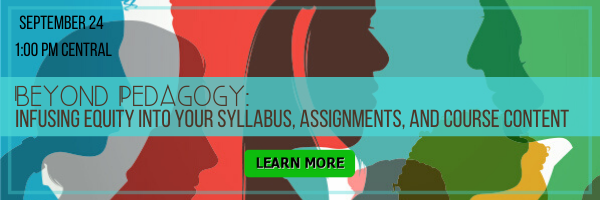This article is featured in the resource guide, Effective Online Teaching Strategies.
You’re committed to equity and inclusion. You’ve been educating yourself about how higher ed systemically and systematically privileges some and disadvantages others, while working to create a just and equitable experience for minoritized students. Active learning pedagogies are already part of your toolbox, and you support your department’s ideas on curricular change. Still, you aren’t quite sure how to translate your commitment into further action. What’s next?
The following article identifies four pedagogical strategies for creating and delivering the equity-minded course you’re seeking. I suspect at least several of these are already familiar to you, so I’ve also included suggestions for how to extend and deepen your use of them. They are presented in no particular order; start with which ever one makes sense for you, your students, and the content you teach.
Let’s jump in.
Make every student feel they belong
Creating a sense of belonging isn’t just about being friendly or kind. It’s about grasping the ways that some of your students experience a classroom as foreign, intimidating, hostile, and/or injurious. It’s about providing a consistent psychosocial, intellectual, and emotional counternarrative to the microaggressions, imposter syndrome, and stereotype threat your minoritized students experience. Yeager and Walton (2011) unpack a variety of proven tactics, several of them remarkably impactful for the time you invest, including:
- normalizing the challenges encountered during learning;
- reminding students that their personal values and strengths matter in the moment; and
- helping students discover the value of your content to their lives.
How to help students feel they belong
If you are already using these, I encourage you to also think about how you can help students feel they belong in your discipline. To generate some ideas for how to accomplish this larger goal, ask yourself these questions:
- How can I regularly demonstrate to all students that their specific backgrounds, experiences, and perspectives are valuable within my field?
- In what ways can my assessments (mock testimony, policy briefs, proposals, reviews) provide the opportunity to get a well-rounded sense of what experts in my field do?
- How do my activities ask students to connect my content to their lived experiences?
Expect every student to succeed
If you haven’t already included instruction on a growth mindset (Dweck, 2007), consider adding a section to your syllabus or mini-workshops to class time. Students who believe that hard work pays off, that mistakes are a normal part of learning, and that stretching yourself, while uncomfortable in the moment, has long term value, are more successful.
But don’t stop there. Also do the kind of deep self-reflection that roots out the ways your own beliefs and behaviors can undermine student success.
Alternative ways to engage with students
Here are three pairs of alternative ways to engage with students born out of my own experience. If the first in the pair better describes your current approach, I encourage you to consider how you can shift your thinking and behavior towards the second.
- Do you focus comments on students’ written work overwhelmingly on the problems? or do you highlight the successes and then strategically identify the one or two items the student can prioritize for improvement. (Hint, if you are line editing your students’ work, you fall into the first category).
- When students provide wrong answers on an exam, do you think to yourself, “Where on earth did they get that idea?” Or do you think, “How do I teach that differently in the future to address that misconception?”
- When students don’t perform well on an assignment, do you assume they aren’t working hard enough or aren’t motivated? Or do you assume that they’re working hard but doing the wrong kind of work (e.g. studying facts rather than focusing on using their knowledge) and build in scaffolding to improve their skills?
Make your processes transparent
Even if you aren’t a fan of formal rubrics, you’ve likely found ways to communicate your expectations for assignments clearly and specifically. This kind of transparency is essential to an equity-minded classroom; when you tell your students what you’re looking for, they are better able to produce that kind of product.
How can you take transparency one step further? Make your thinking obvious (Winkelmas, 2014). As experts, the cognitive processes of our discipline have become intuitive and unconscious for us. We read, integrate, or evaluate literally without a second thought. But our students, especially those from underresourced pre-college educational settings, don’t just have less content knowledge, they also don’t yet have the cognitive skills you may take for granted.
Getting yourself to the point that you can describe exactly how you read, problem-solve, or create takes self-awareness, reflection, and metacognition. But your investment is well worth it! My own experience has taught me that weak performances from students is often less about the content they don’t know and more not having clarity about the processes in which I’m asking them to engage. When I’m more explicit about describing the process, their performance takes a jump forward.
Think of your students as partners
Perhaps you’ve already taken steps towards making students partners in your course. Maybe you collaborate on establishing rules for classroom behavior or have students lead a discussion. Perhaps you use mid-semester evaluations to solicit feedback or maybe there are semester-long group projects, the results of which are shared in the final week of class.
Give students the opportunity to be the expert
But can you take this idea of partnership further and regularly give students the opportunity to be the expert, to do the teaching. Here are a few ideas to get your own creative juices flowing:
- You want students to understand the events that led up to the Civil War – give them the tasks of identifying and evaluating events to add to an annotated, collaborative time line.
- You want students to understand the differences between political systems – have them evaluate how their home region responded to the COVID-19 crisis as examples.
- You want students to grasp landscape ecology – have them evaluate (or design) a landscape of their choice according to the principles.
- You want to students to understand the impact of population growth in the Middle Ages – have them create a model village that then has to change in response to immigration, technological changes, and more efficient agricultural practices.
A last thought.
The beauty of the above four strategies is that they frequently overlap. For example, let’s say you want students in your intro astronomy course to understand the controversy surrounding building a new telescope on Muana Kea, Hawaii. You could lecture or lead a discussion on the topic. Or you could design a well-scaffolded assignment that has different groups each create a brief given a perspective (astronomers, Native Hawaiians, and various state officials). The activity culminates in a summit/hearing/panel discussion based to a decision making body (e.g. governor or judges). In this one activity, you’re validating minoritized perspectives in a field, engaging disciplinary issues, valuing diverse skill sets, putting students in the expert seat, and communicating high expectations. Careful scaffolding can also make transparent the importance of collaboration within science, the social and cultural value of science, and the complexity of decision making.
Join Amy B. Mulnix, PhD, on Thursday, September 24 at 1:00 PM Central for her live, online seminar, Beyond Pedagogy: Infusing Equity into Your Syllabus, Assignments, and Course Content.
Amy Mulnix directs the Faculty Center at Franklin and Marshall College where she works with faculty across their career arc on teaching and learning, scholarship, and leadership. Prior to that, Mulnix taught biology at Earlham College for 22 years.
References:
Dweck, C.S. 2006. Mindset: The New Psychology of Success. New York: Random House
Yeager, D.S. and Walton, G.M. 2011. Social-psychological interventions in education: They’re not magic. Review of Education Research. 81(2): 267-301.
Winkelmas, M. 2014. TILT Higher Ed. https://tilthighered.com/abouttilt. Available under a Creative Commons Attribution-NonCommercial-ShareAlike 4.0 International License







